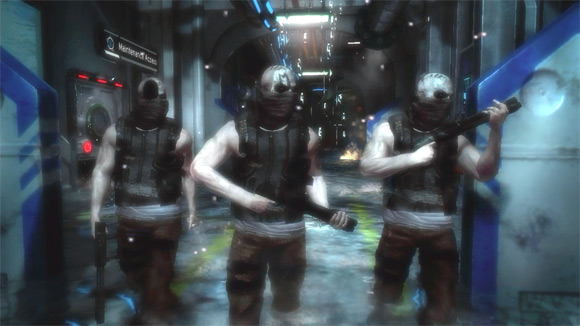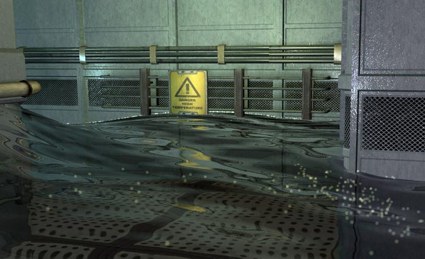This post has not been edited by the GamesBeat staff. Opinions by GamesBeat community writers do not necessarily reflect those of the staff.

As the “To Be Continued” screen fades out at the end of Hydrophobia — yeah, it's that kind of ending — I have very mixed feelings about the abruptness of the ending. Clearly, the game's cliffhanger ending doesn't bother to even try to give the player a sense of closure, and that's subject to much scrutiny. But I'm also a little relieved, because around almost every corner of Hydrophobia's flooded and metallic hallways I felt like I'd been set up then knocked down by either poor design decisions or poorly implemented good ones, and I was a little tired of it.
Hydrophobia's biggest letdown comes from what was supposed to be its biggest strength: water that moved with realism supposedly unmatched by most game physics. And water does in fact behave realistically here; open a door to a room filled with water, and it floods into the adjacent room, not only raising the water level but also pushing you — and enemies — along with it. As water begins to pile up, your trek across the room becomes slower and slower until you eventually have to swim.
It certainly impresses early on, and lets you buy into some the game's cheesy characters and thin plot. Kate and her friend with a stereotypical Scottish accent, Scoot, are the only people capable of stopping a group of Malthusians from taking over a gigantic city-ship and no doubt using it for their nefarious needs. There are documents you can pick up that'll give you some backstory on the both the crew of the ship and the enemy, but unfortunately, having Malthusians as villains — something that could've been a cool idea — amounts to having people who are heavily armed and want to kill anyone who isn't on their side.

Creative and original, right? Right?
And when you're not fighting them, you're pursuing a tedious and generally linear path to the aforementioned cliffhanger ending. Faced with a locked door, you'll either need to change the water level, or find an encryption key, which you'll need to find another key that'll open the locked door.
This is the only mechanic employed that's anything like a puzzle. Most of the times I was stuck were because I had overlooked an inconspicuous set of climbable pipes or had not activated a control panel that was not hinted at in any way.
You could say that I'm a sucker for modern game design's tendency to hold your hand, but with a constant objective marker showing you where you're supposed to be headed, I'm pretty sure that developer Dark Energy went for the modern approach, and just failed to do it right. Collectibles are the only thing that encourage exploration. Aside from that, there is only the objective, and your path to it.
But after an hour or so of water-filled exploration, you've seen the extent of the game's creativity.
Every aspect of Hydrophobia is lifted from third-person games of every variety, and often its interpretation of said aspect is a step back. The platforming, taken from the likes of Tomb Raider, is primitive, and even forsakes the reliability of the A button for jumping, instead mapping it to the Y button; A is for taking cover. It's unnecessarily awkward, and I never really got used to it.
The combat feels just as awkward. The 360's left trigger and bumper are left unused in the story mode, instead having you press the right bumper to take out and put away your weapon (you can't climb pipes while holding a gun, silly).
The game's main combat focus is to use traps in the environment to defeat your enemies rather than attacking them head on, since your sonic gun takes several charged-up shots to stun a foe to death. This usually means one of two things in any given room: either there are going to be red barrels everywhere and you're going to make them all explode, or the enemies aren't going to approach any of the traps, and you'll have to resort to the tedious task of dispatching them with the sonic pistol until they either drown from being stunned in the water to long or dead from being hit and sliding around enough.
 There is a stealth option, but it's limited to a crouch button and moving slowly without any sort of close-range attack until the enemies sees you, after which they will know your location until you kill them with regular combat.
There is a stealth option, but it's limited to a crouch button and moving slowly without any sort of close-range attack until the enemies sees you, after which they will know your location until you kill them with regular combat.
Oh, and remember that left trigger and bumper I said weren't used in story mode? It turns out that they're used to activate Kate's Hydrokinetic (the game's word, not mine), power which allows her to create spires of water, catch enemies in them, then fling both at a wall. It's a cool concept that adds some variety to the combat, but it's too bad that a power that could've made the story mode more interesting is only available in Challenge Mode, which amounts to five waves of ten enemies in a room full of red barrels.
It's not entirely broken, but Hydrophobia is simply built of defective parts that don't fit together all that well. I can definitely see ambition poking through some bad choices, but even at its best, the game doesn't manage to rise above the games it takes clear inspiration from and earn its $15 price tag, instead falling back on tired scenarios and motivations. More likely than not, you've already seen or played this game before, and probably enjoyed it more than you will what is just another knockoff product.
2/5
